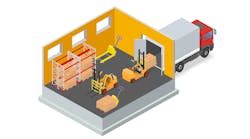Downtime at the loading dock means operations may come to a crawl, or worse yet, a complete stop. Meanwhile, the loading dock remains an unsung hero in today’s supply chain. At the heart of supply chain activity, the most promising material handling operations teams often experience severe disruptions because their loading docks are not effectively maintained. What’s more, unplanned downtime from breakdowns and inefficiencies are incredibly costly. Beyond emergency repair expenses, they can mean extended downtime, slow delivery, higher costs per shipment, lost productivity, increased safety risk, and a drop in ROI.
Add to this the fact that supply chain constraints are creating longer lead times than seen in several decades when securing new equipment and parts. What was once a few days waiting for a specific part may now be a month or more depending on the piece needed or the new equipment required. Meanwhile, e-commerce orders continue to soar as many facilities struggle with an ongoing labor shortage.
The time has come to pay closer attention to the activity at loading docks. According to the Occupational Safety and Health Administration (OSHA), one out of four workplace accidents occur at the loading dock area. Equipment failures alone contribute to thousands of accidents around loading docks, creating serious safety issues and halting operations. Yet this is preventable.
It’s clear that companies that don’t think ahead and invest in proactive care for their essential assets are harming themselves in the long run. Facilities must focus on maintaining stronger proactive maintenance practices for critical equipment—the best way to fight against unplanned downtime. As more businesses and facilities shift their operations to this proactive approach aimed at minimizing downtime, what does this mean specifically for the loading dock?
Here are three lessons to be learned from facilities applying proactive maintenance to maintain operations while avoiding interruptions.
1. Don't wait for equipment to fail.
Facilities that wait for their equipment to fail before taking action lose money and suffer safety repercussions. A better approach is to maintain equipment instead of having to replace it. Better maintained equipment lasts longer, and it should be no surprise that essential equipment needs maintenance and upkeep to achieve uninterrupted operations. In fact, up to 80% of issues that prevent assets from functioning are preventable with maintenance. Avoiding higher costs associated with unpredictable repairs means ROI will not have to pay the consequences of emergency repairs and extended downtime due to preventable issues like bottom panels being impacted by forklift trucks or dock leveler lips not extending.
2. Digitize assets.
Utilizing a maintenance program that digitizes the proactive maintenance process ensures that data and decades of learning are incorporated into every decision. This requires utilizing either an internal system or leveraging a service partner with a platform that can collect and provide real-time information on facilities’ assets such as equipment type, age, manufacturer, capacity, service history, and more. This information is critical to tracking modifications, repairs, and necessary recommendations for proactive maintenance needs.
3. Keep personnel safe.
Better safety means less downtime and proactive maintenance ensures excellent record-keeping and alignment OSHA guidelines and requirements for providing a safe, healthy workplace. Facilities that wait for their equipment to fail before taking action are out of line with OSHA guidance. Productivity and safety can fail due to the danger of supply chain disruptions, with 25% of accidents occurring at the loading dock area and 600 near-misses for every incident that ends up happening. Working with factory-trained service professionals on a strong proactive maintenance strategy can counter these harmful trends.
A proactive maintenance approach is the best way to boost safety, maintain operations and avoid downtime at the loading dock—in some cases, cutting down on the need for unplanned maintenance by up to 50%. In the past, maintenance has been a purely reactive investment for many organizations, but this has proved to be a costly and inefficient approach. The companies securing their role as industry leaders in our supply chain system are those thinking proactively about their loading dock needs.
Dennis Sanacore is vice president of strategic sales at Miner (www.minercorp.com), the docks and doors special division of OnPoint Group. He has more than two decades of experience within the facility services, warehousing and logistics sector.




